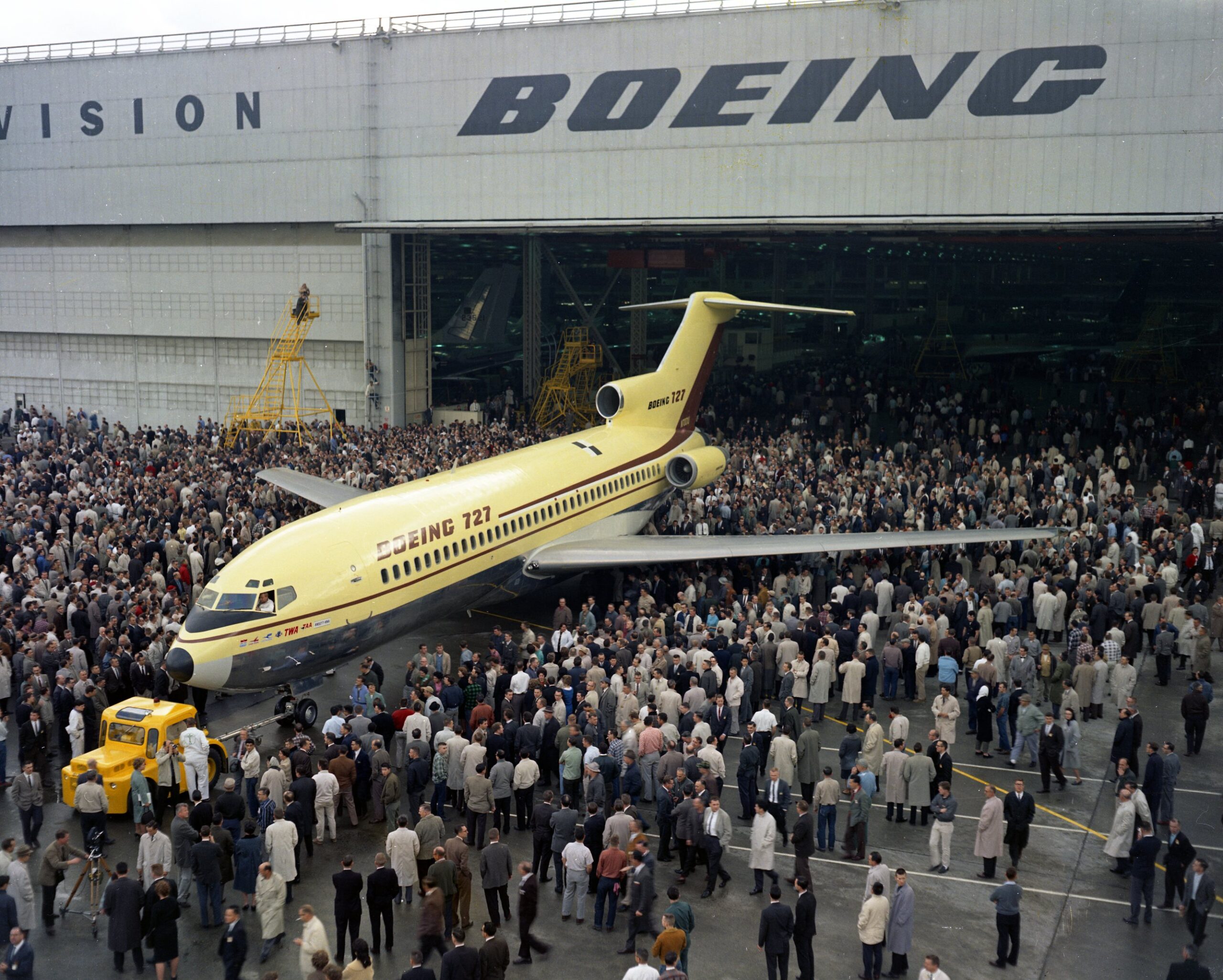The Jet Age began in earnest when Britain’s four-engined De Havilland Comet 4 began flying the Atlantic in 1958, followed by the Boeing 707. These ships shrank the world, but there was more to the world than London, New York, Tokyo and Sydney.
The need for a short haul “bus stop jet” to serve smaller communities was apparent from the start of the jet age, but at Boeing, in 1954 and 1955, every engineer was working flat out to create the 707. Once the 707 was up and running, Boeing was able to create a short haul stopgap with the Boeing 720 – a shorter, lighter 707 optimised for short trips and short runways. The 720 first flew on November 23, 1959, and went into service on July 5, 1960 with United Airlines. Despite its interim nature, Boeing sold 154 720s, many of which remained in service well into the 1980s, demonstrating the size of the market out there for a local jet, and the quality of Boeing’s products at that time.
A Bus Stop Jet
A bus stop jet needed to have structural strength to sustain a high frequency of takeoffs and landings, and be shoehorned on and off short runways, so a robust airframe and excellent low-speed handling was essential. The 720 was a reasonable impersonator but the market needed a bespoke solution, and by 1957, a team of 40 engineers were already hard at work on the machine that would become the 727.
The initial objective was for a gross weight of 61 tonnes (135,000 lbs) and the ability to fly off a runway of 1,500 metres (5,000 feet) without having to leave payload behind. A small and lightweight wing would not be able to deliver that kind of performance so that first big year for the programme was spent on low speed aerodynamic research and development, to achieve the most impressive lift coefficient with a minimum of structural weight and mechanical complexity.
Likely customers were canvassed for their preferences. United Airlines was keen on a four-engined machine to ensure performance at their mile-high hub at Denver; Eastern Airlines were keen on at least three engines for its overwater flights to the islands of the Caribbean, since twins in those days were limited to routings that did not venture more than sixty minutes from land; while domestic-only American Airlines were happy with a twin.
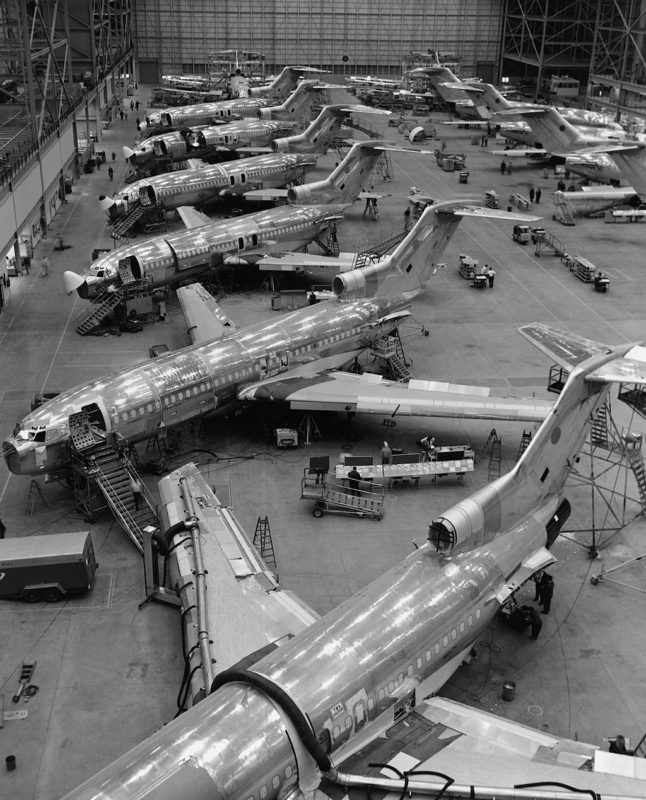
In Britain, de Havilland had settled on a three-engined configuration with a high T-tail at the end of the 1950s for their Trident jetliner. Lord Douglas of Kirtleside, chairman of British European Airways, the Trident’s main customer, suggested Boeing and de Havilland collaborate to create a single design. This spurred the development of the 727 as the Trident design was ahead of the pack (indeed, it beat the 727 into the air by more than a year) when Boeing were given access to de Havilland’s technical data regarding the placement of an engine in the tail, and the structure and aerodynamics of a high T-tail.
With design studies affirmed by their brush with the British, the 727 improved on its competitor – bigger, heavier, more powerful, with much more range and much better runway performance than the Trident, which would end up selling only 117 machines across three variants.
The short runways at New York’s in-town lilypad, La Guardia airport, were an obvious standard that had to be achieved. Down in Florida, Key West’s challenging 4,600 foot (1,403 metre) strip was another notable short field where US airlines wanted to provide jet service. The wing, unencumbered by engines, was able to use flaps, slats, slots, and spoilers to achieve these aims with ease.
Operational autonomy on the ramp at poorly-equipped fields meant the 727 would be the first Boeing with an Auxiliary Power Unit (APU) for providing electrics, air conditioning, and engine start without relying on ground power. A ventral staircase would swing down from under the tail so even stairs were not needed for ground handling.
In the summer of 1962, a team of 5,000 workers were making the first 727 come to life at Boeing’s Renton facility near Seattle. By October, most of the fuselage and cockpit were under construction, with Pratt & Whitney JT8Ds and landing gear in place by the end of the month; in November the aircraft was moved on its own wheels into the ground test area next to the assembly hall. N7001U was rolled out in a formal ceremony on November 27 with orders already placed by some of the biggest names in the industry – United, American, Lufthansa, Eastern, TWA.
The First Flight of B727
Flight-ready JT8Ds were delivered by Pratt & Whitney in January 1963, and final prepartions for the first flight included high speed taxi tests by the flight crew of Lew Wallick (Boeing senior experimental test pilot; 727 project pilot) in command, joined by Dix Loesch (Boeing chief of flight test) in the co-pilot’s seat and M. K. Shulenberger (Boeing chief flight engineer) on the panel.
The first flight took place on February 9, 1963, airborne at 1133 local after a ground run of just over 3,000 feet (915 metres). After a successful two hour sortie, N7001U landed at Paine Field, Everett, where the aircraft would be based for the first ten hours of its test programme, performing general handling and airworthiness checks for the FAA. The flight had been a success, albeit marred by a compressor surge on the centre engine at the point of rotation, an irritation that was partially solved with the installation of vanes inside the duct, and changes to its internal shape to keep the airflow flowing.
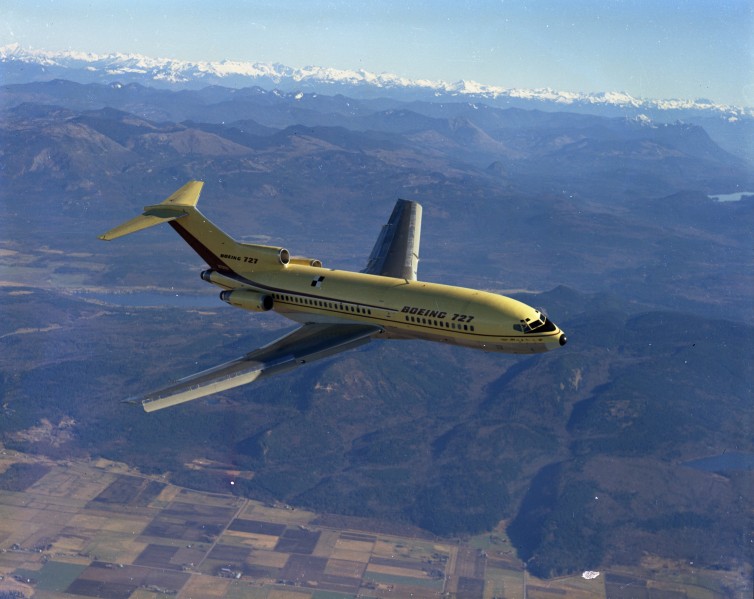
Most of the test programme took place in the Seattle area, based at Boeing Field, and included secondments to Edwards AFB in California, Albuquerque in New Mexico, and Denver. N72700, destined to spend its whole life as a company demonstrator at Boeing, joined the test programme after its first flight on March 12.
Ship 1 performed 430 hours of structural damping and flutter tests while Ship 2 did 320 hours for systems development. A third 727, N7002U, took to the air on April 10 to complete most of the detailed handling and aerodynamic loading trials across 180 hours of flying. The last test aircraft was N68650 (originally N7003U) for All Nippon Airways and Piedmont AIrlines, and performed 313 hours of checking passenger amenities such as pressurization and sound-proofing, and was used as a demonstrator, clocking up over 175,000 miles (281,635 kilometres) along the way, including a world tour that visited twenty-six countries in the course of 139 flights which included local demonstration flights for media, airlines and officials.
The first deliveries were in late 1963, with three machines each handed over to United and Eastern Airlines for pilot training. The first 727 revenue flight was operated by Eastern Airlines on February 1, 1964, replacing a Lockheed Electra propliner on a Miami to Philadelphia via Washington run. A week later United got into the game with a San Francisco to Denver flight.
B727 In Airline Service
In service, the 727 was performing perfectly, with no defects or shortcomings. However, the great leap into the Jet Age was only fifty years after the Wright Brothers' first heavier-than-air flight, and the airline captains of the era had served decades on the flightdecks of propliners that were not only slow but, thanks to the prop wash over the wings, gentle and forgiving to land.
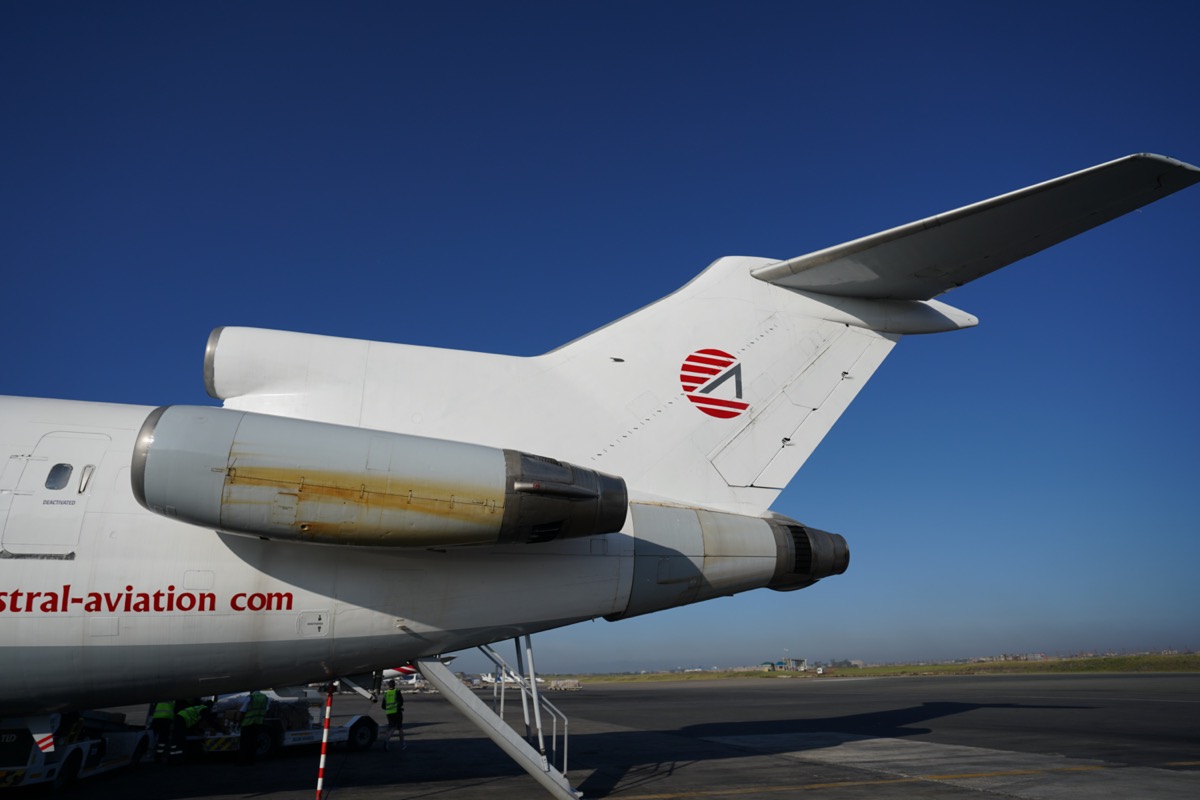
Full flaps on the 727 – forty degrees – created enormous amounts of drag in landing configuration, to be countered by an iron fist of thrust pounding out of the jet pipes of the JT8Ds in the tail, without which a rapid rate of descent could build up, hard to arrest close to the ground.
Most airline pilots converting off piston-powered props thrived on the jets, relishing the high cruising altitudes far above the weather, and the mechanical simplicity of the new powerplants (“It’s as simple as riding a broomstick!” a trainer at Trans World Airlines would tell his cadets at the start of each jet orientation course). However, a few struggled with the high speeds and quickened tempo. A few washed out of the typerating courses and went back to see out the rest of their careers on props. And a few others made it through the jet courses – just.
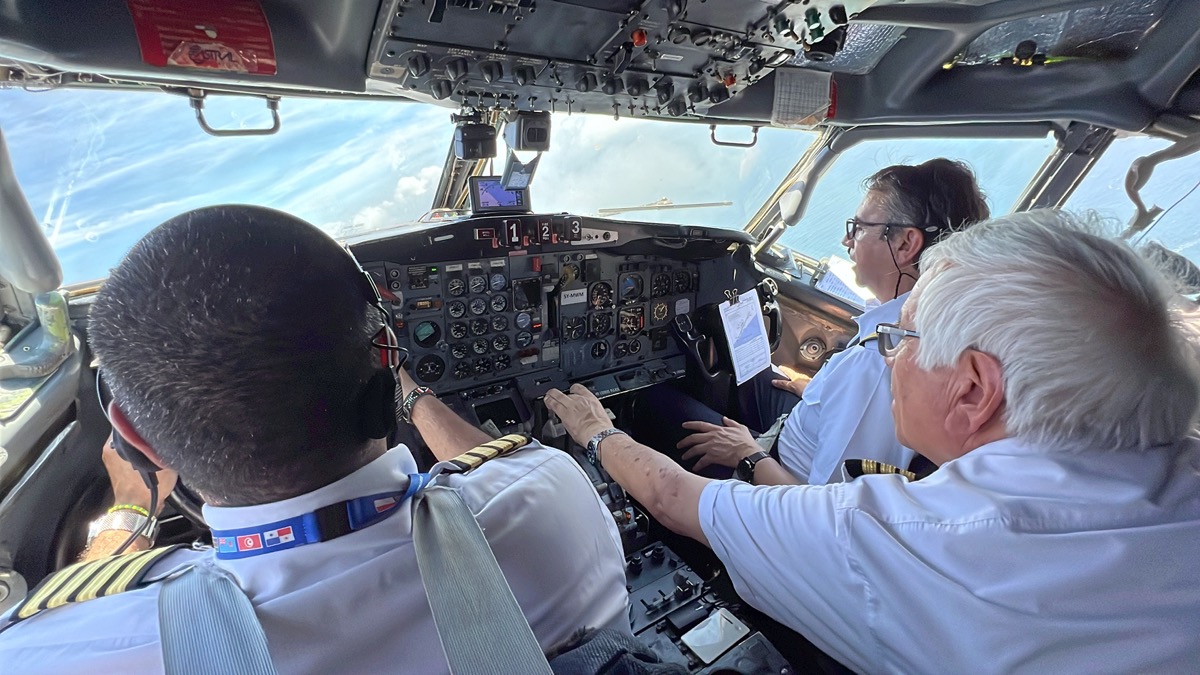
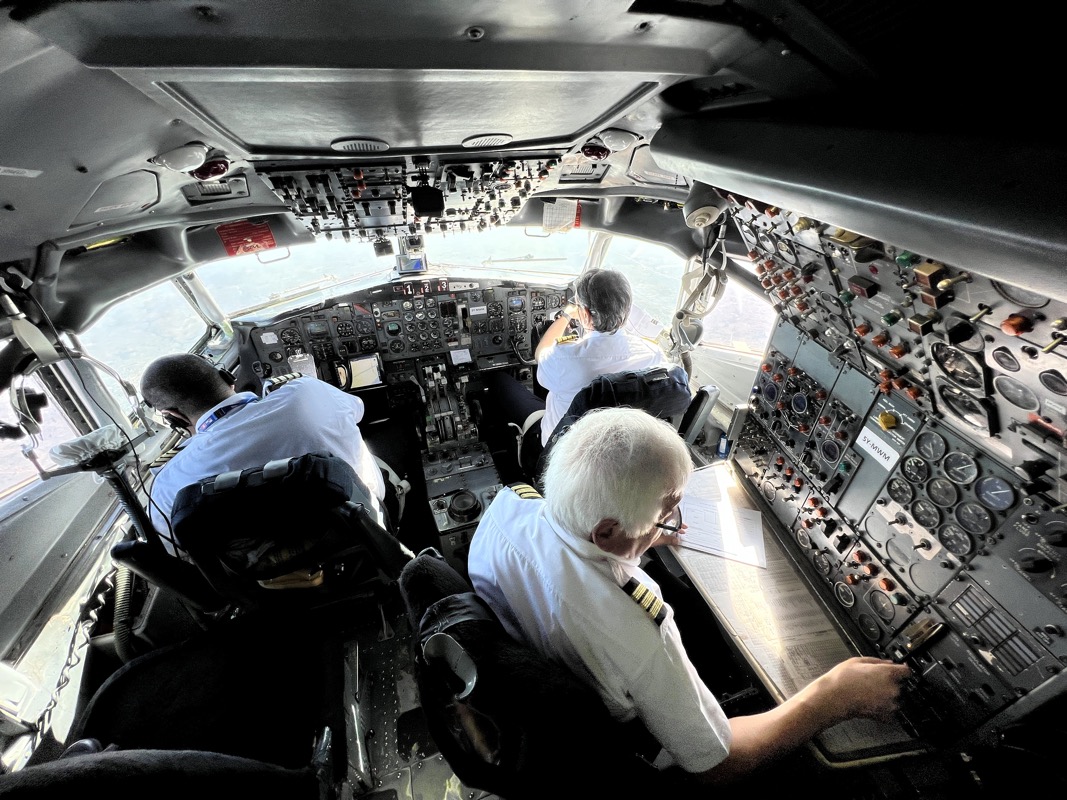
United 389 crashed into Lake Michigan thirty miles northeast of Chicago on August 16, 1965 while maneouvring for landing at O’Hare. On November 8, American 383 lost altitude in the circuit for landing at Cincinnati and crashed into terrain 225 feet (69 metres) below the elevation of the runway. Only three days later, United 227, high on approach at Salt Lake City, achieved a sink rate of 2,300 feet per minute (normal would be around 800 feet per minute) and smashed into the ground short of the runway. On February 4, 1966, All Nippon 060 crashed into Tokyo Bay on approach to Haneda airport.
The combined death toll from the four eerily similar accidents was 263 (with only 52 survivors, most of them in Salt Lake City). The travelling public began to avoid the new Boeing, and Congressional committees even discussed pulling the type’s airworthiness certificate with the Federal Aviation Authority (FAA). In fact there was nothing wrong with the 727 at all, but the new jets had to be flown with precision, by the numbers. In the defence of accident-prone early jet pilots, some of those numbers and procedures were still being figured out by the airlines, thus was life and death at the leading edge of technology. The ultra high drag forty degree flap setting was outlawed by most airlines’ operating procedures, and some went as far as to weld a metal plate across the flap lever slot so it could not be selected.
The Only Unsolved Episode of Air Piracy
On November 24, 1971, a Northwest Orient Airlines 727-151 was involved in the greatest mystery of the Jet Age, flying the last leg of a classic bus stop run from Washington DC to Seattle via Minneapolis, Great Falls, Missoula, Spokane and Portland, when it was hijacked by passenger Dan “D.B.” Cooper. After dropping the passengers off at their destination in Seattle and picking up $200,000 ($1.244 million in 2018) and parachutes, N467US was back in the air. Cooper jumped off the extended rear steps, and was never found, and nor was his true identity ever ascertained. A small boy found a few waterlogged bundles of the ransom – a small fraction of the total – on the banks of the Columbia River in 1980, which if anything only served to deepen the mystery, to this day the only unsolved episode of air piracy in history. After three copycat episodes, a vane was installed on 727s worldwide, blown into place by the rush of oncoming air, making it impossible to extend the stairs inflight, and was known as the DB Cooper Vane.
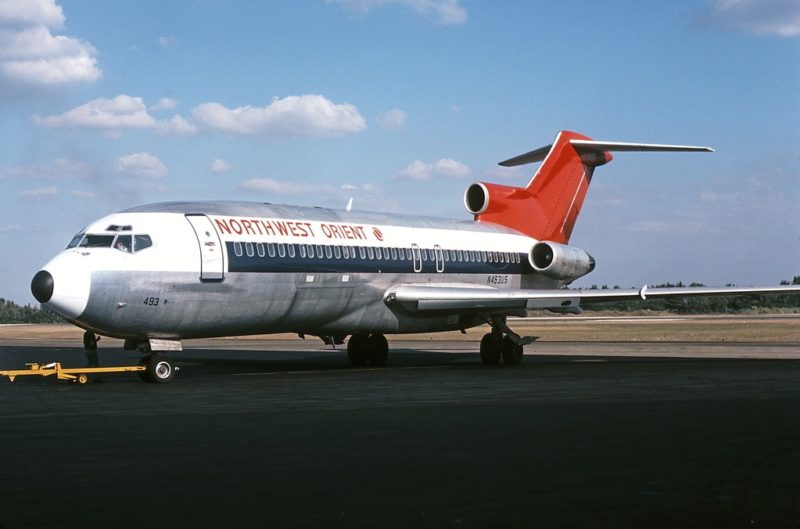
Not long after the 727-100 was in service, a stretched version was on the drawing board, twenty feet (6.1 metres) longer thanks to a ten foot (three metre) plug inserted ahead of the wing and another aft. Although harder to spot, another modification was to make the oval-shaped intake for the number two (centreline) engine round. The first 727-200 took to the air on July 27, 1967, and after FAA certification on November 30, it entered Yellowbird Service out of Boston with Northeast Airlines. The first 310 727-200s had the same maximum gross weight as the 727-100, 169,000 lbs (76.66 tonnes) which, with the additional structural weight of the stretched fuselage, meant less payload or less fuel. These early -200s were pure people-movers, with constrained range, and retained Boeing’s classic 1960s Penthouse interior with open hat racks and large dome lights in the aisle.
After building a total of 881 727s of both fuselage lengths, Boeing launched the 727-200 Advanced, which took advantage of new and more powerful JT8D-15 variants, and added upgraded flight deck instruments and updated passenger accomodation which included enclosed overhead bins and recessed neon lighting, a look known as the Boeing Widebody interior. (There was also a contemporary 707-320B Advanced and 737-200 Advanced with the updated cockpit instruments and Widebody interiors.) The new engines raised the maximum takeoff weight from 169,000 lbs (76,657 kgs) to 191,000 lbs (86,636 kgs), clearing the way for a much heavier fuel load which increased the range of the 727-200A by fifty percent. The first 727-200 Advanced was delivered to All Nippon Airways on June 30, 1972 and was an immediate smash hit, selling 935 machines.
WorldWide Flying
In the United States, the 727 was the definitive short and medium hauler, the public transport backbone of the nation. Braniff, Eastern, Western, United, American, Continental, Northwest Orient, TWA crisscrossed the country with their trijets, most with fleets numbering over 100 airframes.
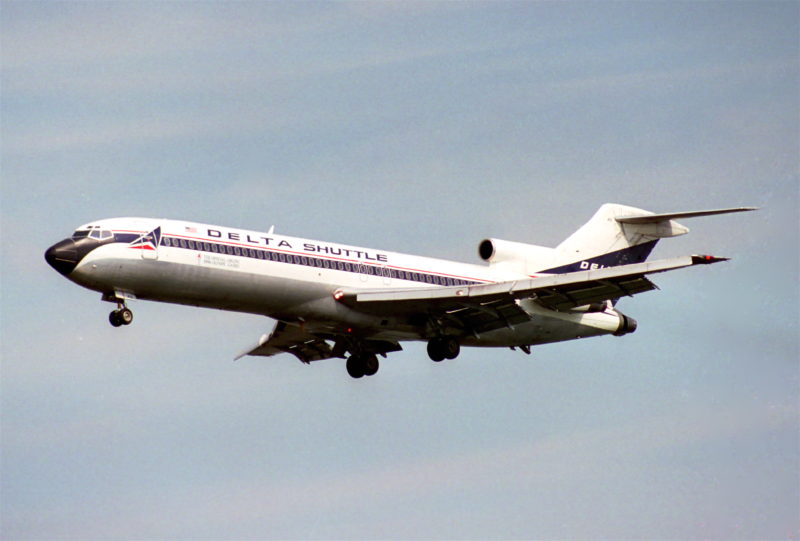
The 727 also found favour across the Arab world, as the regional hardware of choice at Air Algerie, Syrianair, Alia (Jordan), Kuwait Airways, Libyan Arab Airways, Iraqi Airways. (The first aircraft at the now-mighty Emirates Airline was a pair of secondhand 727s, back in 1985.) Australia at the time had what was known as the Two Airline Policy, whereby the state-owned TAA and privately-owned Ansett operated basically identical fleets and schedules, so the two airlines ordered six -100s each and, later, fifteen -200s each. Like in the United States, a whole generation of Australians took their first flights aboard 727s.
Europe, with shorter distances between cities, and with locally-built competition in the form of the very capable British Aircraft Corporation BAC-111, Hawker-Siddeley Trident and Sud Aviation Caravelle, was a tough sell for the 727. Undeterred, after Lufthansa’s early and enthusiastic adoption of what they christened the Europa Jet, Air France, Olympic Airways, Iberia, TAP Air Portugal, Sabena of Belgium and JAT of Yugoslavia became 727 operators, along with a handful of leisure carriers (Denmark’s Sterling Airways, Dan-Air in the UK).
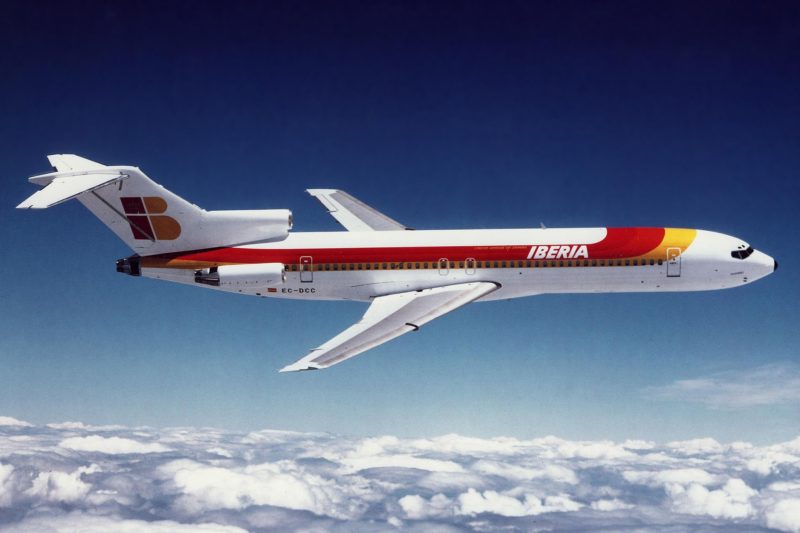
One European operator worthy of note was actually Pan Am, who, in return for a near-monopoly on international traffic rights, were barred from flying domestic within their own country of the United States until deregulation in 1979, but as the US was one of the three guarantors of the tiny exclave of West Berlin deep inside East Germany, Pan Am flew the air corridors out to the rest of West Germany – to Hamburg, Munich, the hub at Frankfurt, and other European cities. United and Delta, who inherited local traffic rights when Pan Am disintegrated at the end of the 1980s, also flew 727s on intra-European sectors in the 1990s.
Although the 727 was intended to serve short- to medium-haul routes, Sterling Airlines of Denmark, Wardair of Canada and American Flyers Airline all used 727-100s on transatlantic charter flights with a fuel stop in Keflavik (Iceland), Gander (Canada) or Bangor (Maine) in the late 1960s and 1970s. In the 1990s Canada’s Royal Airlines flew 727s weekly from Toronto to Tallinn in Estonia.
Federal Express, or Fedex, took fifteen late-build 727-200F Advanced freighers, including N213FE, the 1,832nd and very last 727 off the line, which was handed over on May 24, 1984. It was the end of an era at Boeing, who turned their attention to the 757 and 767; but for the 727 and Fedex the story was just beginning, which would hit reach high noon a decade or two later with 113 727-100s and 106 727-200s in purple livery passing through the ranks at Memphis. The highest number in the fleet at any one time was 170.
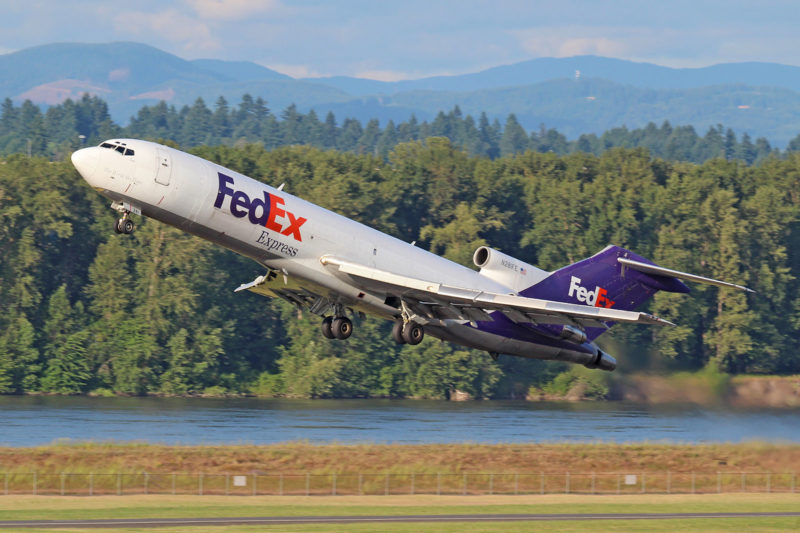
As Fedex wound down its 727 fleet, 83 were donated to schools, universities, museums and law enforcement all across the United States. The last machine to fly for FedEx was N221FE, a 727-233 originally delivered new to Air Canada in 1974 and donated on November 19, 2014 to Beaverbrook School in Dayton Ohio.
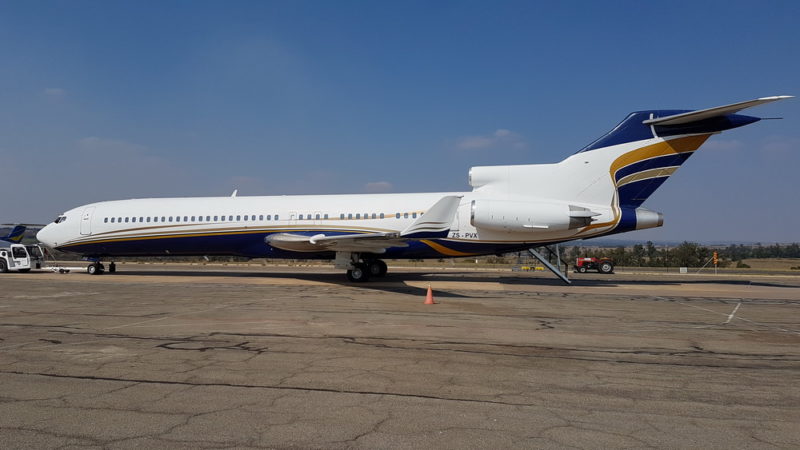
B727-200Adv VIP version (Ex-Nelson Mandela's VIP plane)
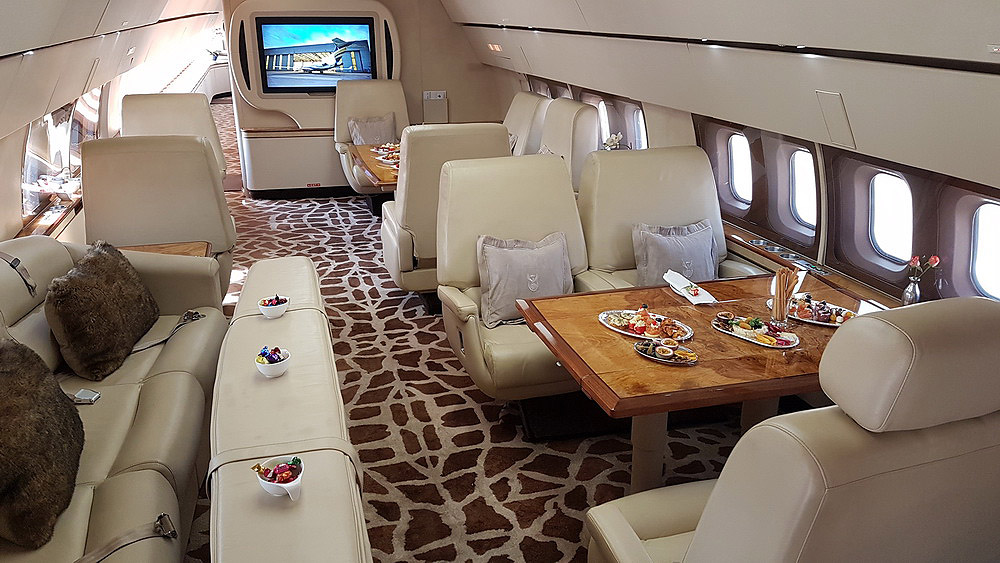
Interior of the B727-200Adv VIP
Self Loading Freight on UPS B727-100
United Parcel Service, or UPS, operated 50 727-100QFs (Quiet Freighter – re-engined with Stage III-compliant Rolls-Royce Tay turbofans) and eight 727-200s. In 1996 a company division called the Asset Utilisation Experiment had five of the -100QFs extensively modified by PEMCO World Air Services in Tampa Florida – N946UP, N947UP, N949UP, N950UP and N951UP. Two permanent lavatories, sidewall trim, flight attendant jumpseats on bulkheads, and TCAS, new anti-collision avionics then only required on passenger liners, not freighters, were all installed. These machines became 727-100QCs, for Quick Change, an old Boeing factory designation for similarly convertible 727s.
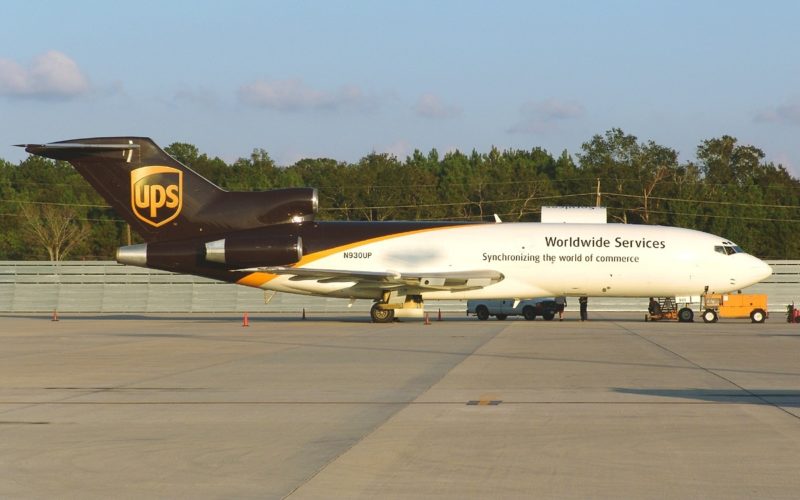
Every Thursday or Friday, these five birds would have overhead bins secured in place, followed by ten pallets rolled aboard via the main deck cargo door, each comprising two complete rows of six electric blue seats with a generous 33” pitch, complete with a chunk of carpeted aisle. Wiring looms were connected up to provide galley power, call buttons, reading lights, seat belt signs. In under four hours, a 727 freighter was ready to fly 113 passengers off to the beach. Flights ran mostly from Pittsburgh, Louisville and Philadelphia, to the likes of Miami, Bermuda, Orlando, Cancun, Aruba, Barbados. Due to the short range of the 727-100, some trips needed a fuel stop, such as Boston to Aruba, which included 40 minutes on the tarmac at Orlando for a splash-and-dash. Despite being a leisure / charter only affair, service included hot meals and free alcohol in flight with a a hot towel service during descent.
The interiors were intended to be interchangeable but in fact each fuselage was a slightly different shape – manufacturing tolerances on 1960s aeroplanes were not what they are today, plus a few decades of flight had taken their toll. Aircraft were having to be ferried to be reunited with ‘their’ QC interior, so it was decided to leave them permanently in full passenger configuration, all week. The subfleet was profitable and pilots liked the trips (daylight flying and flight attendants were both a novelty), but using the planes to fly boxes was more profitable, so after five years the five jets were returned to cargo hauling for the remainder of their lives.
At the turn of the century, fleets of 727s were ageing but still going strong in the same niches they had been dominating since the end of the 1960s. Retirement plans were made, and orders for 737NGs placed. However, with the downtown in travel and economic activity following the terrorist attacks of September 11, 2001, those plans were dusted off and put into action with immediate effect. Within a year of 9/11, the 727 had vanished from frontline service (and trijets in general, as the DC-10 and Tristar suffered an identical fate).
A few supplemental operators pressed on with the 727 – Challenge Air, American Trans Air and Planet Airways in the United States, Sabre in the United Kingdom. Latin and South American carriers used 727s as freighters. As a barometer of the kind of operators now flying the 727, the last major accidents to befall the type were both overloaded aircraft running out of runway on takeoff – UTAGE 141 crashing on Christmas Day 2003 in Benin, destination Beirut, with the loss of 141 lives out of 163 aboard; and Aerosucre 4544 on December 20, 2016 with the loss of five of its six crew in Colombia.
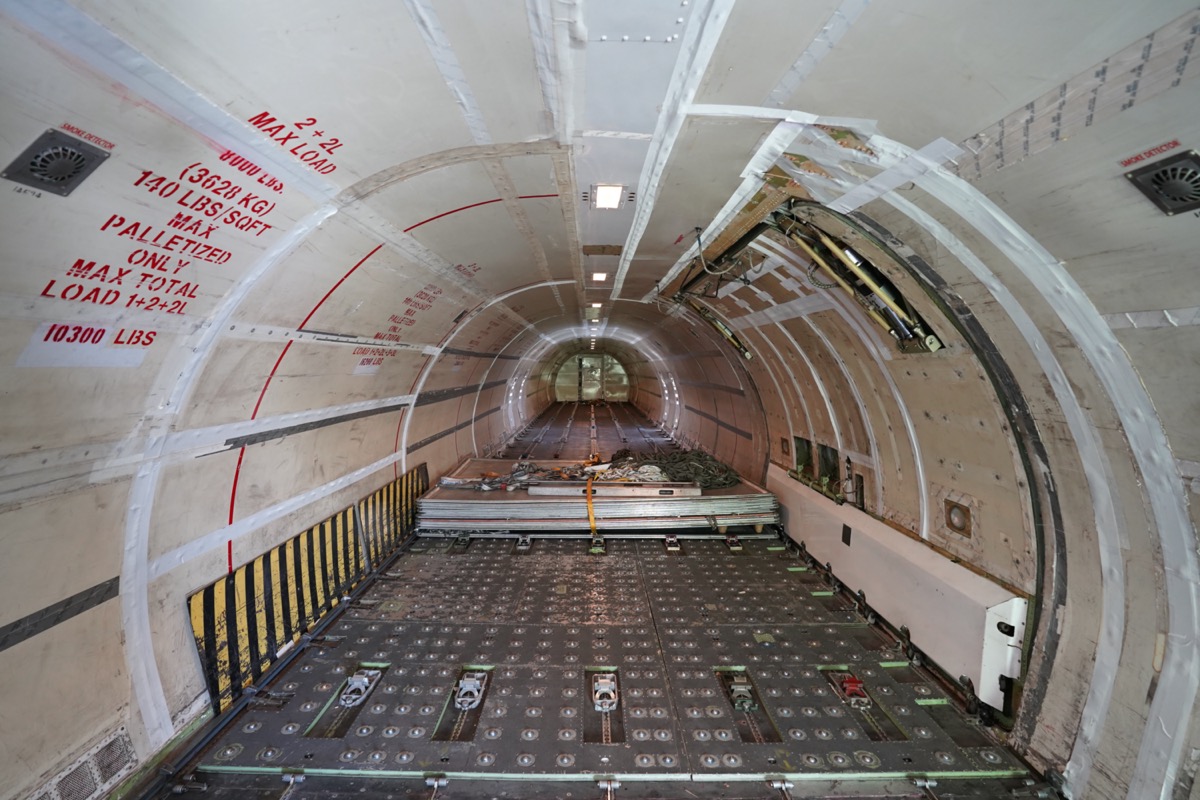
Late-era 727 operators weren’t all marginal fly-by-nighters. First Air in Canada’s frozen north provided essential service with their custom 727-100s to gravel runways in remote places like Resolute Bay and Nanisivick in the province of Nunavut (same size as Mexico, population 35,000) using special tires, gravel deflection kits, and uprated brakes. The last two were parked in 2009. Kalitta, a legend of US air freight, retain a handful including a specialised horse transporter known as Air Horse One. T2 Aviation flies a pair of ex-DHL 727s out of Doncaster in the United Kingdom, modified with spray booms to disperse oil spills at sea.
At the time of writing, there are a dozen 727s in service. Even stalwart Amerijet, who flew pallets of catering and other supplies out of Miami on 727s to holidaymakers in the Caribbean and were a beloved early-morning staple at Saint Martin, retired the type in 2018. The last passenger operator was Iran Aseman Airlines with a pair of 1980-vintage 727-228s, which retired on January 13, 2019, marking the end of an era that had lasted fifty-five years since the first 727 passenger flight in 1964.
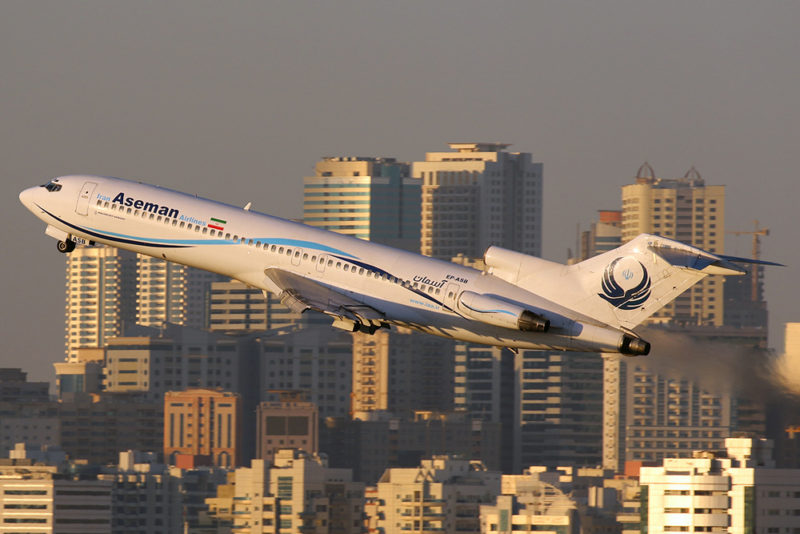
The story of the 727 is the story of humanity learning to fly, bringing jet speeds and sounds to the masses, plugging the suburbs, the small towns and small cities of the world into the grid of the Jet Age.
Model Summary
| Model Series | ICAO code | Orders | Deliveries |
|---|---|---|---|
| 727-100 | B721/R721 | 407 | 407 |
| 727-100C | B721 | 164 | 164 |
| 727-200 | B722 | 1245 | 1245 |
| 727-200F | B722/R722 | 15 | 15 |
| Total | 1831 |


